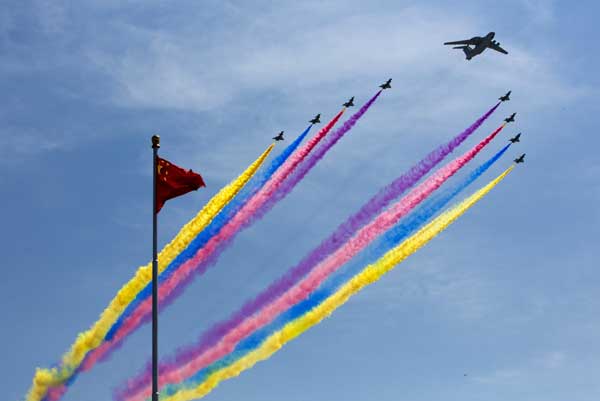PLA deploys advanced jets to boost electronic capability
 0 Comment(s)
0 Comment(s) Print
Print E-mail China Daily, September 4, 2015
E-mail China Daily, September 4, 2015
 |
|
A KJ-2000 airborne early warning and control system leads J-10 fighter jets flying past a national flag during the victory parade marking the 70th anniversary of the end of World War Two, in Beijing, China, September 3, 2015. [Photo/Agencies] |
China now has better information and electronic warfare capabilities as the People's Liberation Army has deployed some of the world's most advanced support aircraft, an aviation analyst said.
"A total of six types of electronic warfare planes and airborne early-warning and control aircraft were displayed at Thursday's parade. They are now key components of the PLA's information and electronic warfare capabilities," said Wang Ya'nan, deputy editor-in-chief of Aerospace Knowledge magazine.
"These aircraft will cooperate in an actual strike operation to form a unified platform that is capable of integrating not only combat planes but also ground weapons and naval hardware," he said, noting this is a major breakthrough in the PLA's effort to strengthen its joint operational capabilities.
During Thursday's military parade, nearly 200 aircraft of more than 20 types formed 10 formations and flew over Chang'an Avenue in Beijing, in the largest-ever display of the nation's military aircraft.
Support aircraft were the highlight of the air display. They included the PLA air force's KJ-2000 and KJ-500 airborne early-warning and control aircraft and the Y-8 maritime patrol aircraft of the PLA navy's aviation wing.
The KJ-500 is the latest addition to the PLA's support aircraft fleet. The aircraft, which entered service earlier this year, has one fixed phased-array radar and two passive electronic intelligence arrays, according to IHS Jane's Defense Weekly. The United Kingdom-based publication quoted a Chinese television report as saying that this aircraft can track up to 100 targets simultaneously to a range of 470 km.
Wang said that compared with its predecessor, the KJ-200, the KJ-500 boasts more advanced electronic instruments and 360-degree coverage, making it as powerful as the KJ-2000. Meanwhile, contrary to the KJ-2000's limited production caused by the use of the Russian Ilyushin Il-76 airframe, the KJ-500 can be mass-produced thanks to its adoption of the domestically developed Y-8 transport plane, he added.
Thursday's air display also marked the first public appearance of the PLA navy's information warfare aircraft, which has substantially improved the navy's maritime reconnaissance, surveillance and command capabilities and enable it to monitor a vast area of airspace in a timely manner, according to Wang.
In addition to supporting combat aircraft, some of the displayed planes have another unnoticed potential – they can relay data and conduct terminal guidance for ballistic missiles, Wang said.
"For instance, in an anti-carrier operation, the ship may keep moving, which requires the missiles to have very accurate terminal guidance. Here we can use the combination of military satellites and electronic support aircraft to help the missiles home in on their targets," he explained.
Long-range force
H-6K, the latest variant of the H-6 bomber and possibly the only member of the five-decade-old family that can be defined as a genuine strategic bomber, also took part in the display.
The deployment of the H-6K means the PLA air force possesses a long-range strike capability and can take out any target along the second island chain, which runs from the Bonin Islands in the north and moves southward through the Marianas, Guam and the Caroline Islands, Wang said.
"Despite the aircraft having an old aerodynamic design and lacking stealth capacity, its improvements in avionics and its engine enable it to carry cruise missiles to launch beyond-visual-range strikes on ground targets or ships," he said.
Compared with older H-6 variants such as the H-6H that appeared in the 2009 parade, improvements to the H-6K have made it a brand new bomber altogether because 90 percent of its equipment has been upgraded, according to Bao Lianjing, commander of the bomber formation in Thursday's parade.
Fu Qianshao, an aviation equipment expert with the PLA air force, said the military will continue to upgrade the H-6 series and will develop a new long-range strategic bomber.
He added the PLA air force will also increase it use of unmanned aircraft because they have proved to be more effective and flexible than manned planes in some operations.
"The display of the BZK-005 high-altitude, long-range reconnaissance drone and the GJ-1 medium-altitude, long-endurance reconnaissance and attack drone indicate that China has developed types that are more advanced than these," he explained. "We are among the few nations with the technological capability to develop large military drones. They will gradually replace manned aircraft."
"The appearance of these advanced aircraft reflect the fact that China is one of a few countries that is able to independently develop such sophisticated systems," he added.
0






Go to Forum >>0 Comment(s)